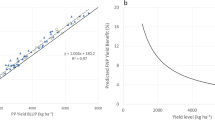Summary
Approximately 27 000 maize x tripsacum pollinations were made and 19 hybrids were identified. Fourteen of these hybrids were of the classical type, which possesses the full gametic complement of chromosomes from each parent. These hybrids are more like tripsacum than maize. They are perennial, tiller profusely, and begin to flower in approximately two years from germination. So far, none of these hybrids has produced pollen and all backcrosses have been unsuccessful.
Five of the 19 hybrids were not of the classical type, and possessed a variable number of chromosomes in cells of the same root tip. Most cells examined contained 20 maize and no tripsacum chromosomes. Other cells contained 20 maize chromosomes and up to eight of tripsacum. However, in at least three hybrids some cells contained a total of 20 chromosomes, of which up to four were tripsacum substitution chromosomes. These five non-classical hybrids are more maize-like, and are annual. Most have flowered within three months of germination. Although they have produced no viable pollen, four plants have set seed after backcrossing to maize.
The production of F1 hybrids is discussed with view to their subsequent assessment and utilization for maize improvement.
Similar content being viewed by others
References
Beadle, G. W. 1930. Genetical and cytological studies on Mendelian asynapsis in Zea mays. Cornell Univ. Agric. Exp. Sta. Mem. 129: 1–23.
Davies, D. R. 1974. Chromosome elimination in interspecific hybrids. Heredity 32: 267–270.
De Wet, J. M. J., L. M. Engle, C. A. Grant & S. T. Tanaka 1972. Cytology of maize-Tripsacum introgression. Am. J. Bot. 59: 1026–1029.
Galinat, W. C. 1977. The origin of corn. In: Corn and corn improvement. New York, Academic Press.
Green, C. E. 1977. Prospects for crop improvement in the field of cell culture. HortSci. 12: 7–10.
James, J. 1978. Maize x Sorghum. Maize Gen. Coop. News Letter 52: 12–13.
Mangelsdorf, P. C. 1974. Corn its origin, evolution and improvement. The Belknap Press of Harvard University Press, Cambridge, Mass., U.S.
Randolph, L. F. 1955. Cytogenetic aspects of the origin and evolutionary history of corn. In: Corn and corn improvement. p. 16–61. New York, Academic Press.
Author information
Authors and Affiliations
Rights and permissions
About this article
Cite this article
James, J. New maize × Tripsacum hybrids for maize improvement. Euphytica 28, 239–247 (1979). https://doi.org/10.1007/BF00056581
Received:
Issue Date:
DOI: https://doi.org/10.1007/BF00056581




